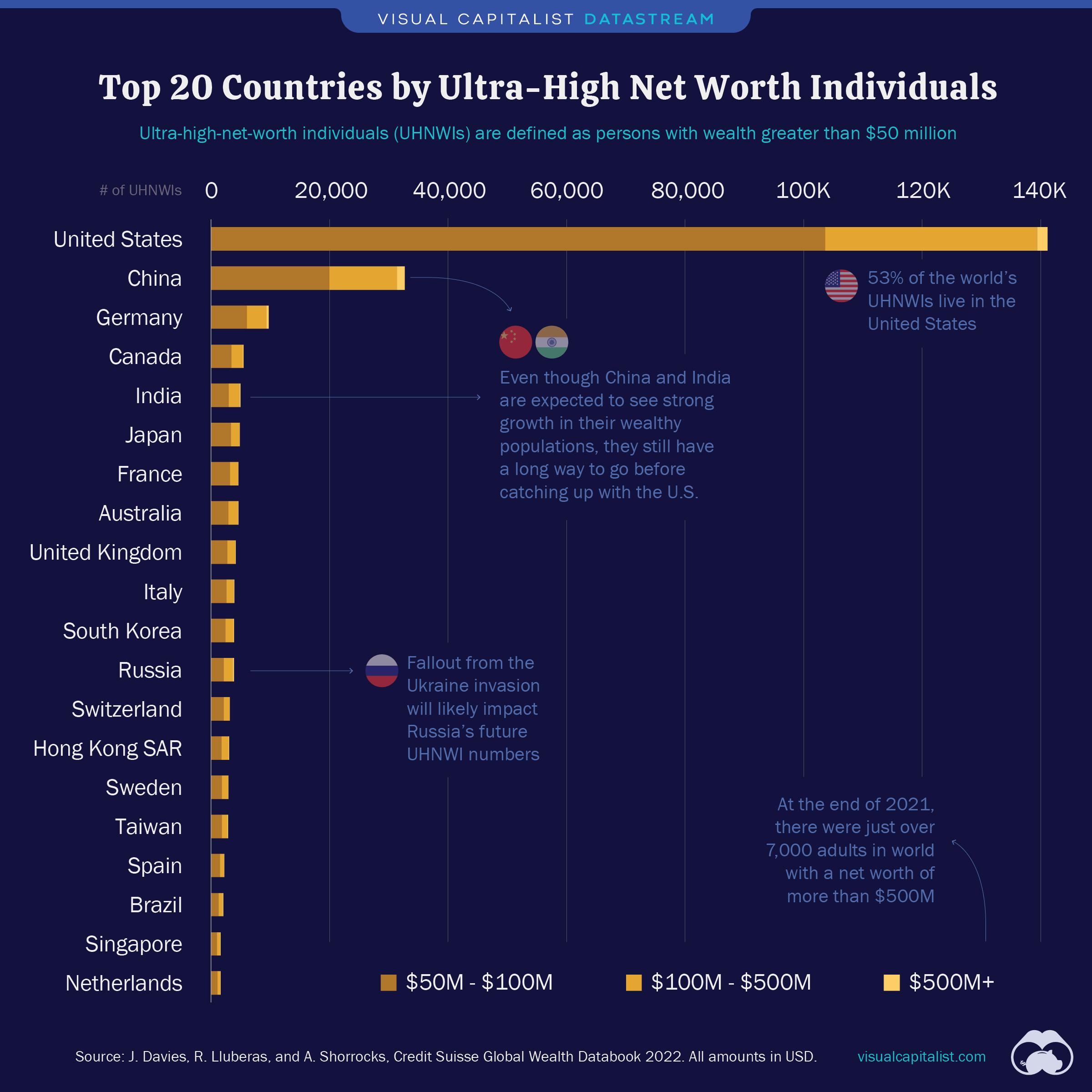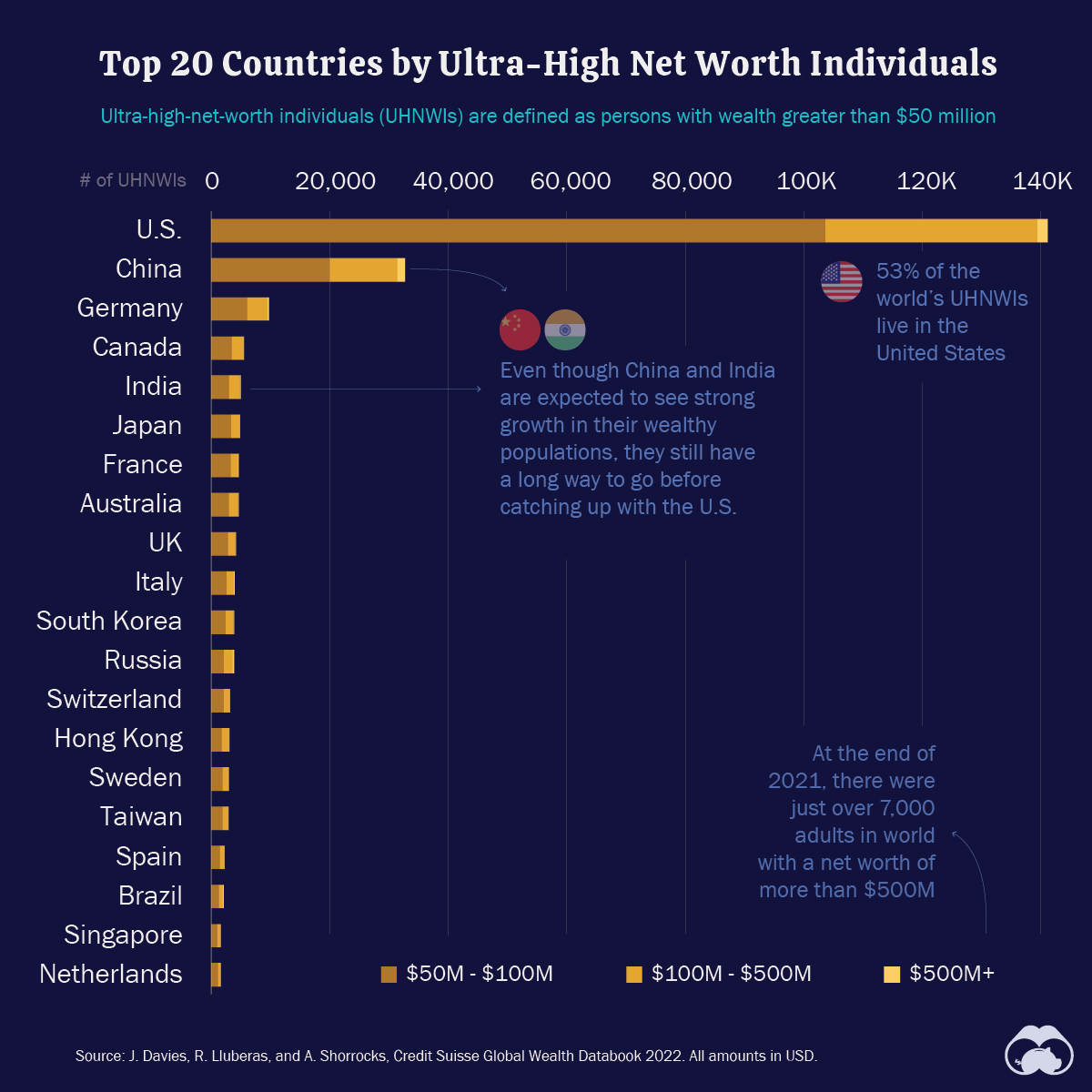Datastream
Top 20 Countries With the Most Ultra-Wealthy Individuals

The Briefing
- According to Credit Suisse, there are now 218,200 people globally with assets over $50 million.
- The majority (53%) of the world’s ultra-wealthy people live in the U.S.
Top 20 Countries With the Most Ultra-Wealthy Individuals
New data from the Credit Suisse Global Wealth Report shows that there was an “explosion of wealth” last year.
The global population of ultra-high net worth individuals (UHNWIs) grew by 46,000 to a record of 218,200. The report notes that UHNWIs benefited from a surge in the value of financial assets last year.
These increases are more than double the increases recorded in any other year this century. – Global Wealth Report 2022
The majority of ultra-wealthy individuals already reside in the United States, but 2021 saw a staggering increase of 30,470 people bring added to this exclusive ultra-wealthy category in the country.
| Country/region | Net Worth of $50–$100M | Net Worth of $100M–$500M | Net Worth of $500M+ |
|---|---|---|---|
| 🇺🇸 United States | 103,669 | 35,740 | 1,726 |
| 🇨🇳 China | 20,013 | 11,411 | 1,282 |
| 🇩🇪 Germany | 6,052 | 3,354 | 318 |
| 🇨🇦 Canada | 3,472 | 1,912 | 123 |
| 🇮🇳 India | 3,024 | 1,750 | 210 |
| 🇯🇵 Japan | 3,373 | 1,411 | 88 |
| 🇫🇷 France | 3,237 | 1,314 | 85 |
| 🇦🇺 Australia | 2,947 | 1,576 | 109 |
| 🇬🇧 United Kingdom | 2,787 | 1,278 | 110 |
| 🇮🇹 Italy | 2,574 | 1,253 | 103 |
| 🇰🇷 South Korea | 2,450 | 1,319 | 117 |
| 🇷🇺 Russia | 2,134 | 1,488 | 253 |
| 🇨🇭 Switzerland | 2,115 | 987 | 92 |
| 🇭🇰 Hong Kong SAR | 1,790 | 1,139 | 127 |
| 🇸🇪 Sweden | 1,866 | 1,019 | 76 |
| 🇹🇼 Taiwan | 1,874 | 912 | 93 |
| 🇪🇸 Spain | 1,509 | 666 | 51 |
| 🇧🇷 Brazil | 1,238 | 749 | 95 |
| 🇸🇬 Singapore | 974 | 570 | 73 |
| 🇳🇱 Netherlands | 1,100 | 471 | 28 |
China and India will likely see their ultra-wealthy populations increase dramatically, but still have a long way to go before catching up to the United States.
The biggest increases, aside from the U.S., were China (5,200), Germany (1,750), Canada (1,610), and Australia (1,350).
Decreases in UHNWI populations were more rare, but did occur in a few cases. United Kingdom (-1,130), Turkey (-330), and Hong Kong SAR (-130) saw the biggest drops.
Where does this data come from?
Source: Credit Suisse Global Wealth Databook 2022
Data note: All amounts in USD
Datastream
Can You Calculate Your Daily Carbon Footprint?
Discover how the average person’s carbon footprint impacts the environment and learn how carbon credits can offset your carbon footprint.

The Briefing
- A person’s carbon footprint is substantial, with activities such as food consumption creating as much as 4,500 g of CO₂ emissions daily.
- By purchasing carbon credits from Carbon Streaming Corporation, you can offset your own emissions and fund positive climate action.
Your Everyday Carbon Footprint
While many large businesses and countries have committed to net-zero goals, it is essential to acknowledge that your everyday activities also contribute to global emissions.
In this graphic, sponsored by Carbon Streaming Corporation, we will explore how the choices we make and the products we use have a profound impact on our carbon footprint.
Carbon Emissions by Activity
Here are some of the daily activities and products of the average person and their carbon footprint, according to Clever Carbon.
| Household Activities & Products | CO2 Emissions (g) |
|---|---|
| 💡 Standard Light Bulb (100 watts, four hours) | 172 g |
| 📱 Mobile Phone Use (195 minutes per day)* | 189 g |
| 👕 Washing Machine (0.63 kWh) | 275 g |
| 🔥 Electric Oven (1.56 kWh) | 675 g |
| ♨️ Tumble Dryer (2.5 kWh) | 1,000 g |
| 🧻 Toilet Roll (2 ply) | 1,300 g |
| 🚿 Hot Shower (10 mins) | 2,000 g |
| 🚙 Daily Commute (one hour, by car) | 3,360 g |
| 🍽️ Average Daily Food Consumption (three meals of 600 calories) | 4,500 g |
| *Phone use based on yearly use of 69kg per the source, Reboxed | |
Your choice of transportation plays a crucial role in determining your carbon footprint. For instance, a 15 km daily commute to work on public transport generates an average of 1,464 g of CO₂ emissions. Compared to 3,360 g—twice the volume for a journey the same length by car.
By opting for more sustainable modes of transport, such as cycling, walking, or public transportation, you can significantly reduce your carbon footprint.
Addressing Your Carbon Footprint
One way to compensate for your emissions is by purchasing high-quality carbon credits.
Carbon credits are used to help fund projects that avoid, reduce or remove CO₂ emissions. This includes nature-based solutions such as reforestation and improved forest management, or technology-based solutions such as the production of biochar and carbon capture and storage (CCS).
While carbon credits offer a potential solution for individuals to help reduce global emissions, public awareness remains a significant challenge. A BCG-Patch survey revealed that only 34% of U.S. consumers are familiar with carbon credits, and only 3% have purchased them in the past.
About Carbon Streaming
By financing the creation or expansion of carbon projects, Carbon Streaming Corporation secures the rights to future carbon credits generated by these sustainable projects. You can then purchase these carbon credits to help fund climate solutions around the world and compensate for your own emissions.
Ready to get involved?
>> Learn more about purchasing carbon credits at Carbon Streaming
-

 Misc1 week ago
Misc1 week agoHow Hard Is It to Get Into an Ivy League School?
-

 Technology2 weeks ago
Technology2 weeks agoRanked: Semiconductor Companies by Industry Revenue Share
-

 Markets2 weeks ago
Markets2 weeks agoRanked: The World’s Top Flight Routes, by Revenue
-

 Demographics2 weeks ago
Demographics2 weeks agoPopulation Projections: The World’s 6 Largest Countries in 2075
-

 Markets2 weeks ago
Markets2 weeks agoThe Top 10 States by Real GDP Growth in 2023
-

 Demographics2 weeks ago
Demographics2 weeks agoThe Smallest Gender Wage Gaps in OECD Countries
-

 United States2 weeks ago
United States2 weeks agoWhere U.S. Inflation Hit the Hardest in March 2024
-

 Green2 weeks ago
Green2 weeks agoTop Countries By Forest Growth Since 2001













